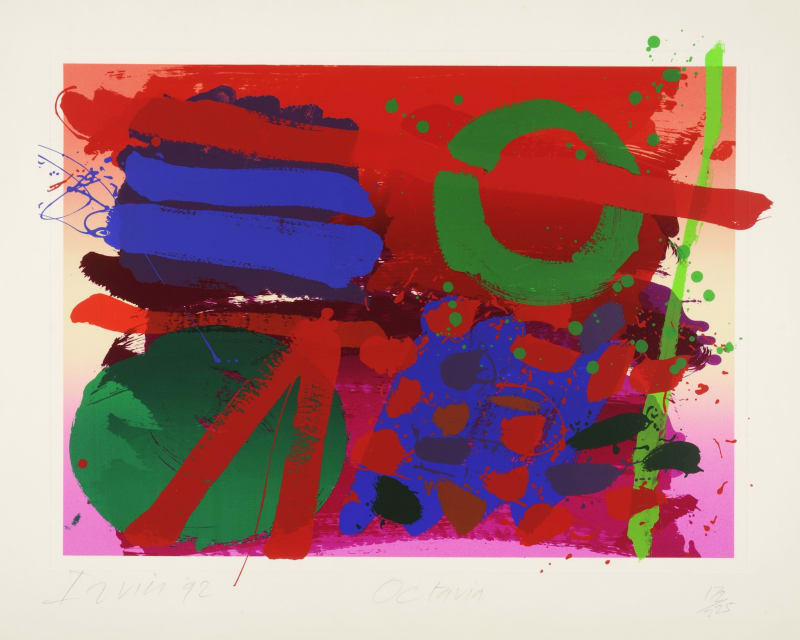
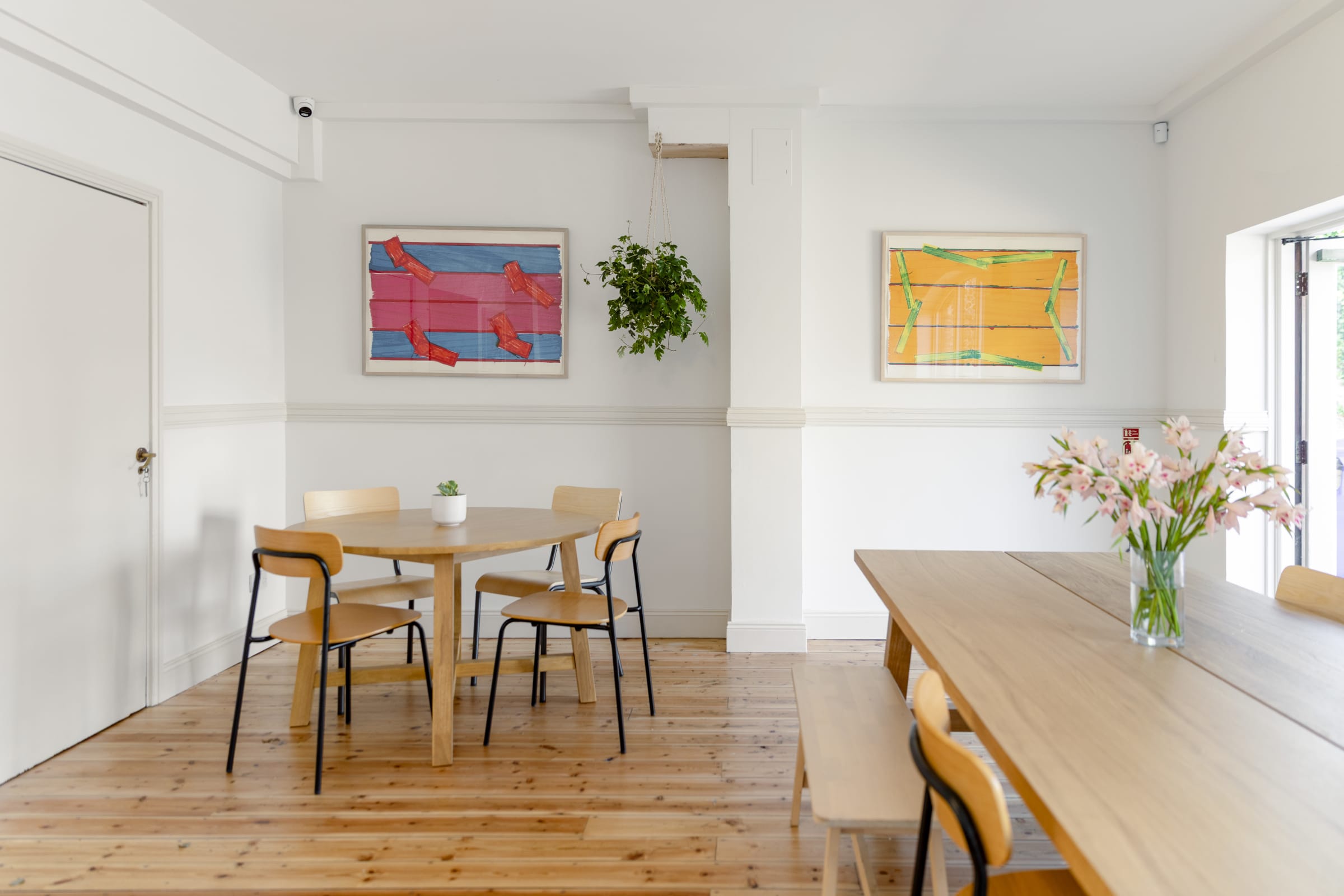
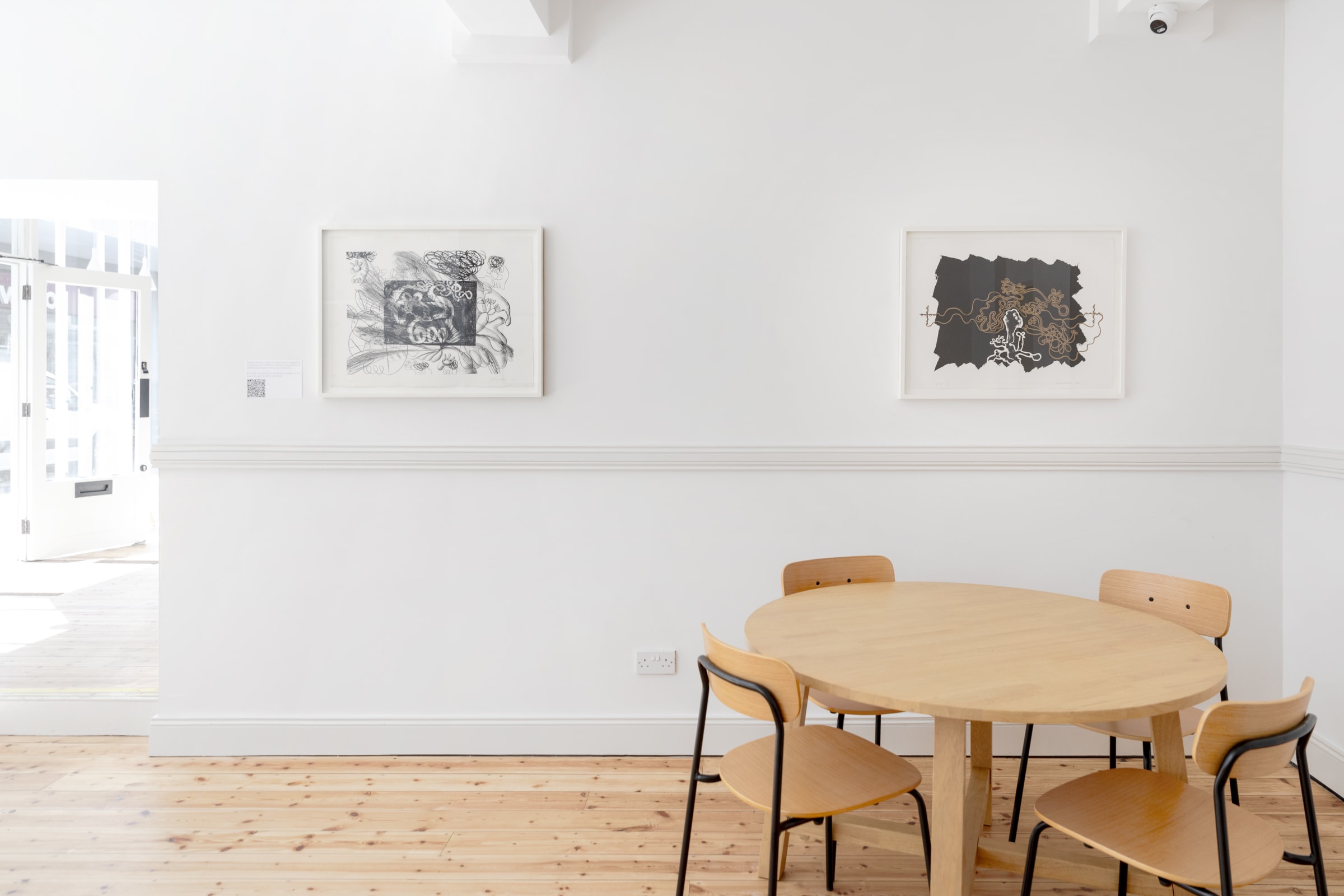

STAPLE Ramsgate
Overview
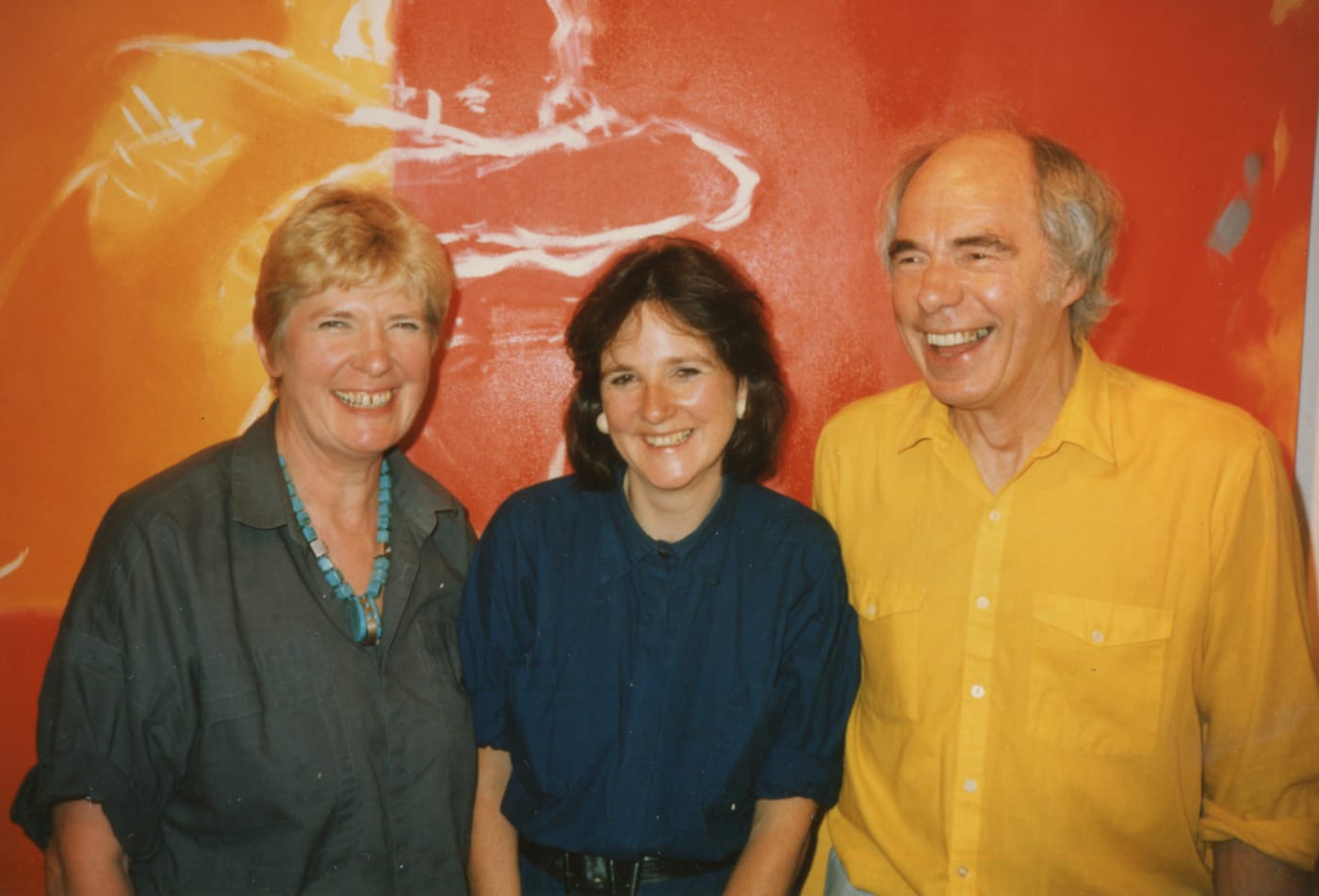
Albert Irvin OBE RA HRWA (1922-2015)
Albert Irvin was a prolific British artist, best known for his exuberant paintings, watercolours, screenprints and gouaches. He was born in London in 1922 and, apart from brief periods during WWII, continued to live and work there throughout his life. His art focusses on capturing and exploring the experience of being in the world.
After the war Irvin returned to his passion for art, enrolling at Goldsmiths College in 1946. He graduated four years later with a National Diploma in Design. Irvin returned to Goldsmiths in 1962 as a teacher and remained there for a further twenty years. He continued painting and printmaking until he died on 26th March 2015, aged 92 in St George’s Hospital, London.
In 1986 Irvin participated in Artist of the Day, a landmark programme started by Angela and Matthew Flowers in 1983. The fast-paced, revolving two-week exhibition features 10 UKbased artists, each presenting a one-day solo exhibition at Flowers Gallery, supported by their artist selector.
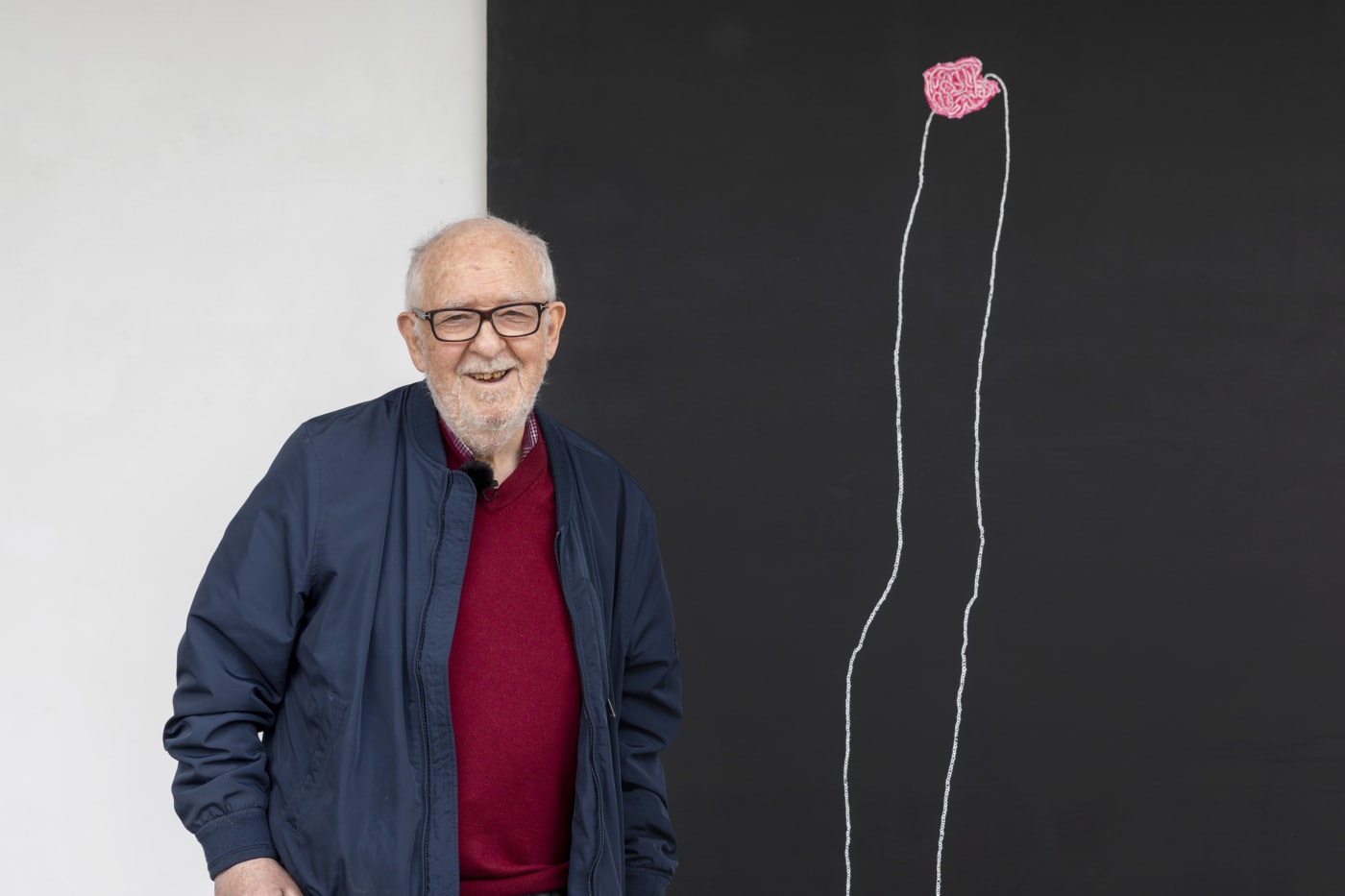
BERNARD COHEN (b 1933)
Born in London, where he lives and works, Bernard Cohen studied at the Slade School of Fine Art from 1951-1954. In 1988 he was appointed as Slade Professor and Director of the Slade School of Fine Art, University College, London. Cohen's work came to prominence during the 1960s and has since been exhibited extensively.
Public exhibitions include a retrospective at the Hayward Gallery, London in 1972, which toured to Newcastle and Leeds; Artist in Focus, Six Paintings from the Tate Gallery Collection, Tate, London in 1995; Stroll on! Aspects of British Abstract Art in the Sixties, Mamco, Musée d'Art Moderne et Contemporain, Geneva in 2006; and Abstraction and the Human Figure at CAM's British Art Collection, Calouste Gulbenkian Foundation, Lisbon in 2010. In 2017 Cohen's work was exhibited as a Spotlight exhibition at Tate Britain, with a supporting film It's A Matter of Dancing With Chaos here.. (This link opens in a new tab). In 2018 Cohen featured in Post-Pop at the Gulbenkian Foundation, Lisbon and in Kaleidoscope at the Walker Art Gallery, Liverpool.
Bernard Cohen's work is held in numerous public collections including the British Council, Tate, the Victoria & Albert Museum, and MoMA.
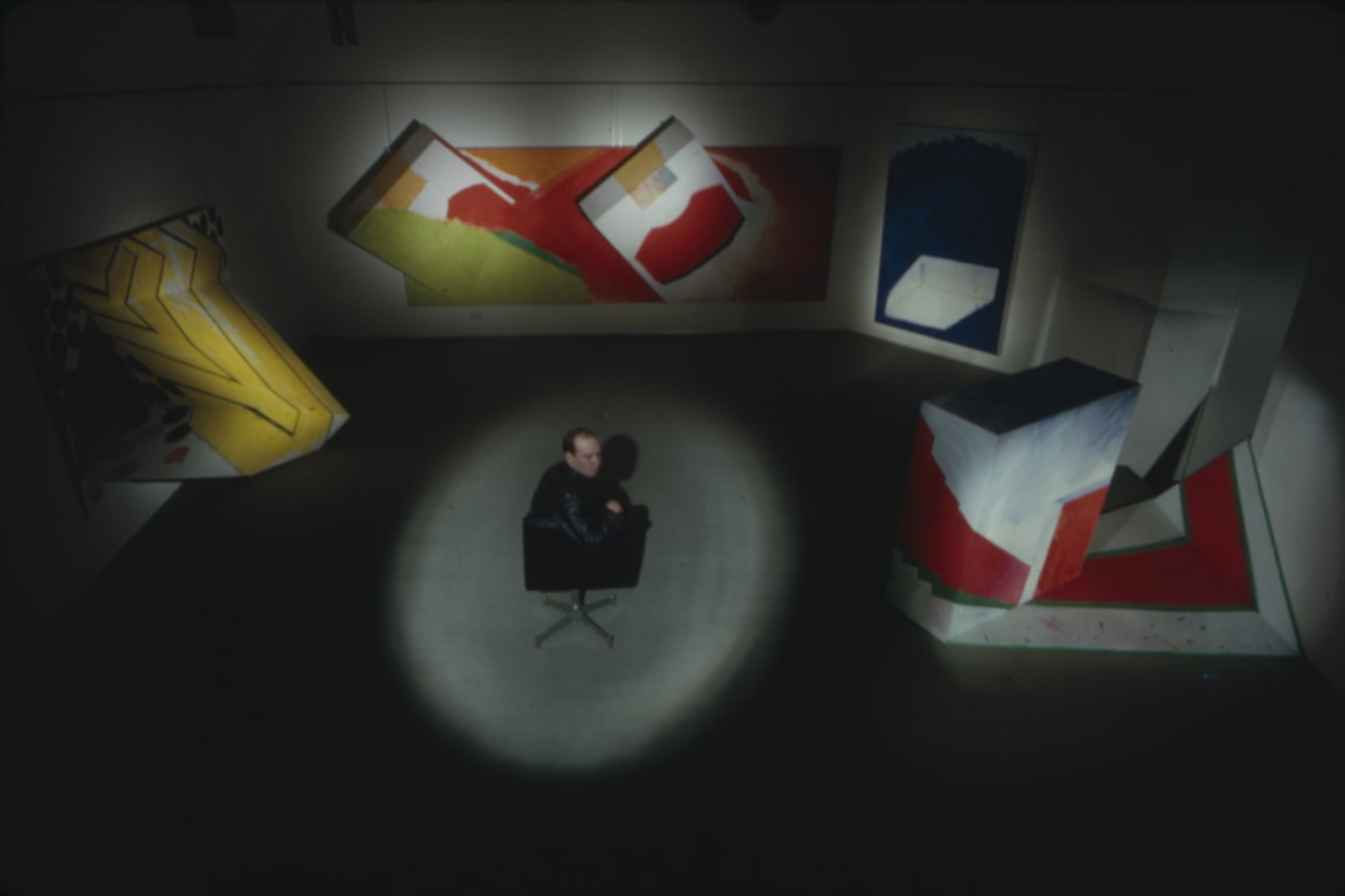
RICHARD SMITH, CBE (1931–2016)
Richard Smith was one of the most influential artists of his generation. After studying in the 1950s at the Royal College of Art alongside artists such as Peter Blake and Robyn Denny, Smith stood apart from the burgeoning Pop Art movement of the 1960s by melding the slick and vibrant imagery found in the commercial landscape with an expansive abstract painting language very much his own. He gained critical acclaim for extending the boundaries of painting into three dimensions, creating sculptural shaped canvases with monumental presence, which literally protruded into the space of the gallery.
Born in Hertfordshire in 1931, Richard Smith was awarded the prestigious Harkness Fellowship in 1959 which facilitated his move to New York, where he had his first solo show at Green Gallery. While still in his thirties Smith had a 1966 retrospective at the Whitechapel Gallery and participated in some of the most important exhibitions of his time, such as Place at the ICA in 1959; Situation at RBA Galleries in 1960; and Painting and Sculpture of a Decade at Tate in 1964. After being awarded the Grand Prize at the 9th São Paulo Biennial in 1967 and participating in Documenta IV, Kassel in 1968, Smith represented Britain at the 1970 Venice Biennale and was awarded the CBE in 1971. Seven Exhibitions 1961-75, a major retrospective, was held at Tate in 1975.
Smith's work is extensively held in public collections including the Arts Council England; The British Museum, London; Metropolitan Museum of Art, New York; the Museum of Modern Art, New York; Tate, London; Victoria and Albert Museum, London; Walker Art Center, Minneapolis; the Whitney Museum of American Art, New York; MIT, Boston; and Philadelphia Museum of Art.

LUCY JONES (b 1955)
British artist Lucy Jones is renowned for her raw, wild landscapes and distinctively provocative portraits, characterised by expressive abstract brushwork and vibrant colour. Balancing an intricate rendering of line and space in her landscapes with the powerful simplicity of her portraits, Jones' paintings conduct a journey through both interior landscapes and the external world beyond.
The artist, who was born with cerebral palsy, has faced the frustrations of her disability over-crowding people's perceptions of her by using her defiant ferocity, vulnerability and wry sense of humour, turning the attention back onto the viewer. Lucy Jones spends long periods working outside in the landscape, particularly along the borders of England and Wales. The paintings which have arisen from these prolonged engagements respond to the particular sensations of place and the revolving cycles of the seasons. The landscape paintings can also evoke a sense of Jones' own physicality through the visceral energy implied by each mark, evident in the language she uses to describe her process: "grabbing hold" of its essence, and "pinning down" colour. Within each arrangement, memories of space, rhythm and colour are reinvented, beginning with an initial tonal reaction to a pre-coloured ground.
Lucy Jones studied at Camberwell School of Art, followed by the Royal College of Art, where she won a Rome scholarship in 1982. Her work has featured in exhibitions at Cartwright Hall Gallery, Bradford Museum, Bradford; Whitechapel Gallery, London; National Portrait Gallery, London; Scottish National Portrait Gallery, Edinburgh; Compton Verney, Warwickshire; Usher Gallery, Lincoln; Salisbury Cathedral; She exhibited at the Attenborough Arts Centre, Leicester, (2019), following a commission of a portrait of Grayson Perry to celebrate the Attenborough Arts Centre’s patrons in 2017; and at Christchurch College, Oxford, (2021). In 2021 Lucy Jones won the Ruth Borchard Self Portrait Prize, and joined the panel of judges for the 2023 Self Portrait Prize.
Lucy Jones’ work is included in the collections of the Arts Council, London; the National Portrait Gallery, London; Clifford Chance, London; Deutsche Bank AG, London; Government Art Collection, London; Nordstern Collection, Cologne; and the Metropolitan Museum of Art, New York, among others. The monograph Lucy Jones: Awkward Beauty was published by Elephant in 2019, with essays by Charlotte Jansen, Tom Shakespeare, and Philip Vann.

SIR TERRY FROST (RA) (1915-2003)
Terry Frost is one of Britain's most significant artists, with a career spanning six decades. Part of the pioneering generation of British abstract artists associated with St Ives, Cornwall, during the 1950s, Frost is renowned for his poetic forms. Often with bright and exhilarating colours and shapes sparking off each other like electric charges, his work radiates energy outwards. Throughout his career, in addition to painting, he made mobiles and three-dimensional constructions alongside linocuts and etchings, with all media and formats inspiring the others.
Terence Ernst Manitou Frost was born in Leamington Spa, Warwickshire in 1915 and was raised by his grandmother. He left school at fourteen and worked odd jobs until World War Two. In the conflict, Frost served with the cavalry and the commandos until he was captured in 1941 in Crete, Greece by the German army. He spent four years as a German Prisoner of War in Stalag 383, a camp in Hohenfels, Bavaria. It was during his imprisonment that he first began to paint, inspired by fellow Prisoner of War and 20th century British painter Adrian Heath (1920-1992). With limited artistic materials, Frost had to use his creativity to improvise. He constructed an easel from old Red Cross boxes, made paintbrushes from shaving brushes, implemented blackout blinds as canvases and used sardine oil as a replacement for turpentine. In April 1945 prisoners including Frost were liberated.
After the war, Frost returned to England and studied at St Ives School of Art in 1946 under the founder Leonard Fuller (1891-1973). He continued his studies at Camberwell School of Art in London from 1947 until 1950 and was tutored by British artists Sir William Coldstream (1908-1987) and Victor Pasmore (1908-1998). In the 1950s, following his studies in London, he moved to St Ives. In this seaside Cornish town, Frost became part of a close group of British modernists working with abstraction, rising to prominence alongside Barbara Hepworth, Patrick Heron, Roger Hilton, Peter Lanyon, Ben Nicholson and Bryan Winter.
Frost's abstraction is based in the formal depiction of motion and gesture, creating his own energetic emblems and symbols of crescents, spirals and semi-circles, generally hanging or balanced in the composition. His paintings are not a reproduction or delineation of nature; he was interested in painting space, light and colour and the complex relationship between the three components in the world.
Frost was also a professor, teaching art at Bath Academy of Art, Leeds College of Art, and Reading University. The recipient of numerous accolades, including the John Moores Painting Prize in 1965, Frost became a Royal Academician in 1992 was knighted in 1998. He continued his practice until he died in 2003. Frost's work is represented in international art collections including Tate, London; the Victoria & Albert Museum, London; the Metropolitan Museum of Art, New York; and the Scottish National Gallery of Modern Art, Edinburgh.


